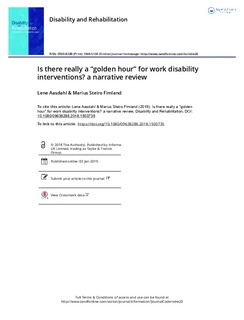| dc.contributor.author | Aasdahl, Lene | |
| dc.contributor.author | Fimland, Marius Steiro | |
| dc.date.accessioned | 2020-03-02T07:18:02Z | |
| dc.date.available | 2020-03-02T07:18:02Z | |
| dc.date.created | 2019-01-04T12:33:03Z | |
| dc.date.issued | 2019 | |
| dc.identifier.citation | Disability and Rehabilitation. 2020, 42 (4) | nb_NO |
| dc.identifier.issn | 0963-8288 | |
| dc.identifier.uri | http://hdl.handle.net/11250/2644503 | |
| dc.description.abstract | The subacute phase of low back pain has been termed as the “golden hour” to intervene to prevent work disability. This notion is based on the literature up to 2001 and is limited to back pain. In this narrative review, we examined whether the current literature indicate an optimal time for return to work (RTW) interventions. We considered randomized controlled trials published from 1997 to April 2018 assessing effects of occupational rehabilitation interventions for musculoskeletal complaints (15 included), mental health disorders (9 included) or a combination of the two (1 included). We examined participants’ sick leave duration at inclusion and the interventions’ effects on RTW. Most studies reporting an effect on RTW included participants with musculoskeletal complaints in the subacute phase, supporting that this phase could be a beneficial time to start RTW-interventions. However, recent studies suggest that RTW-interventions also can be effective for workers with longer sick leave durations. Our interpretation is that there might not be a limited time window or “golden hour” for work disability interventions, but rather a question about what type of intervention is right at what time and for whom. However, more research is needed. Particularly, we need more high-quality studies on the effects of RTW-interventions for sick listed individuals with mental health disorders. | nb_NO |
| dc.language.iso | eng | nb_NO |
| dc.publisher | Taylor & Francis | nb_NO |
| dc.relation.uri | https://www.tandfonline.com/doi/abs/10.1080/09638288.2018.1503735 | |
| dc.rights | Attribution-NonCommercial-NoDerivatives 4.0 Internasjonal | * |
| dc.rights.uri | http://creativecommons.org/licenses/by-nc-nd/4.0/deed.no | * |
| dc.title | Is there really a “golden hour” for work disability interventions? a narrative review | nb_NO |
| dc.type | Journal article | nb_NO |
| dc.type | Peer reviewed | nb_NO |
| dc.description.version | publishedVersion | nb_NO |
| dc.source.volume | 42 | nb_NO |
| dc.source.journal | Disability and Rehabilitation | nb_NO |
| dc.source.issue | 4 | nb_NO |
| dc.identifier.doi | 10.1080/09638288.2018.1503735 | |
| dc.identifier.cristin | 1650365 | |
| dc.relation.project | Norges forskningsråd: 238015 | nb_NO |
| dc.description.localcode | © 2018 The Author(s). Published by Informa UK Limited, trading as Taylor & Francis Group. This is an Open Access article distributed under the terms of the Creative Commons Attribution-NonCommercial-NoDerivatives License (http://creativecommons.org/licenses/by-nc-nd/4.0/), which permits non-commercial re-use, distribution, and reproduction in any medium, provided the original work is properly cited, and is not altered, transformed, or built upon in any way. | nb_NO |
| cristin.unitcode | 194,65,20,0 | |
| cristin.unitcode | 194,65,30,0 | |
| cristin.unitname | Institutt for samfunnsmedisin og sykepleie | |
| cristin.unitname | Institutt for nevromedisin og bevegelsesvitenskap | |
| cristin.ispublished | true | |
| cristin.fulltext | original | |
| cristin.qualitycode | 1 | |

